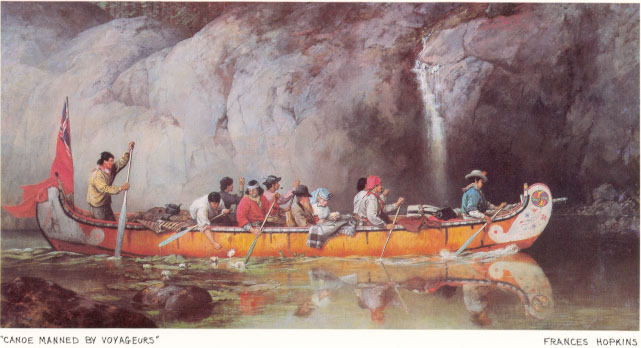The Fur Trade
Fur traders and explorers were the first European people to come to what is now Alberta. Explorers came up rivers by canoe to see what lands lay west of the Great Lakes. Traders wanted to trade with indigenous people for beaver pelts needed in Europe for making beaver hats.
The fur trade, which began in eastern Canada almost four hundred years ago, gradually moved westward. By 1800, several trading posts had been built in what is now Alberta.
Indigenous people provided early fur traders with food and shelter, and taught them skills necessary for living off the land. Fur traders learned how to build canoes; make moccasins, toboggans and snowshoes. They also learned best ways of trapping and hunting for food.

Three of the long-term early fur-trading posts were at Fort Chipewyan in the north, and Rocky Mountain House and Fort Edmonton along the North Saskatchewan River. These locations were accessible by boat or canoe.
(In the Elk Point area, the Fort George and Buckingham House fort sites tell the fur trade story here).
Early fur traders journeyed to Alberta from Montreal and from York Factory. The trip was long, dangerous and exhausting, voyageurs sometimes paddling their canoes for up to twenty hours a day. They needed to get to the forts before freeze-up. Where the rivers were too fast or there were too many rapids, they had to make portages (places where canoes and supplies had to be carried overland).
The Hudson's Bay Company (HBC) and the North West Company (NWC) were the main fur trading companies to build posts in western Canada.
The HBC was established by an English royal charter in 1670. It was granted a commercial monopoly over the entire Hudson Bay drainage basin, which became known as Rupert's Land. In 1774, York Factory, on the shore of the Hudson Bay, became the main trading post. Here British fur traders lived, waiting for indigenous people from the interior of the continent to bring furs to trade.
French fur traders, in what is now eastern Canada, had a different system. They travelled inland, building posts close to where indigenous people lived, learning indigenous languages and forming alliances through marriage to indigenous women.
By 1783, The NWC, founded by a group of Scotsmen from Montreal, following the French fur traders practices, became a main contender for furs. For about thirty-five years, the HBC and the NWC fought bitterly over the fur trade. In 1821, they merged under the name of the Hudson's Bay Company.



